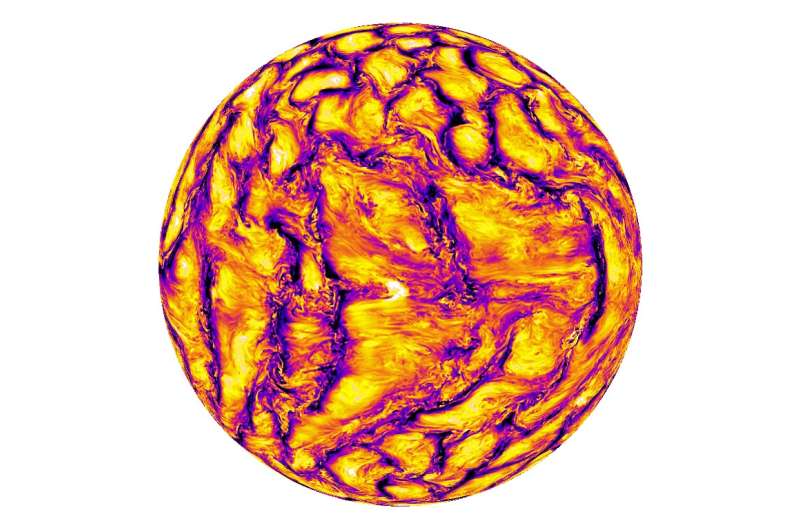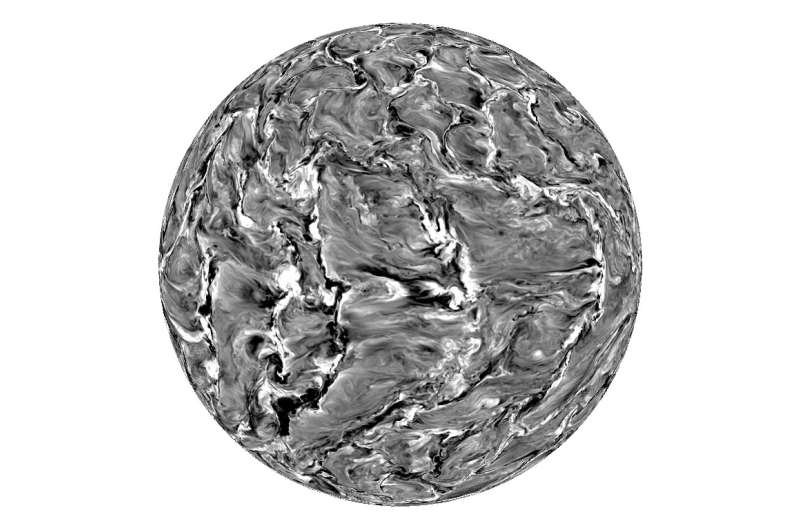March 25, 2016 report
New simulation of the sun shows both large and small scale processes

(Phys.org)—A team of researchers from the U.S., China, and Japan has developed a computer simulation of the sun that is able to show both large and small scale processes. In their paper published in the journal Science, the team describes how their simulation works and why they believe it will help solve one of the big questions in solar research.
Over the years, scientists have developed different tools for helping to understand how the sun works, in more recent years, simulations have been developed that seek to demonstrate the sun's activities, one of which is the 11 year cycle of magnetic field reversal. But, such simulations have been divided into two main categories, those that simulate large processes, and those that simulate relatively small processes. The goal has been to merge the two to allow for a better overall look at how the sun works in general, and to answer the question of how it is that the sun manages to maintain a steady large-scale magnetic field in spite of a there being what appears to be nothing but chaos at smaller scales. In this new effort, the researchers believe they have moved closer to being able to answer that question, by developing a new type of simulation of the sun that finally allows for including both large and small processes.
To create the new simulation, the researchers used math to reduce small-scale diffusivities (parameters that are used to describe how the sun works as a whole), which allowed for minimizing the impact on the means by which the sun generates an electromagnetic field. That allowed for the creation of a whole new range of images.

Thus far, the simulation has not answered the question of how the sun is able to maintain its large scale magnetic field, but the researchers suggest it has to do with small-scale but strong magnetic fields with low viscosity, suppressing the apparent chaos, thereby allowing for the maintenance of the large overall field. They hope to use their new simulation method to better understand the 11 year cycle because of the important role it plays in sending particles to Earth, causing problems for satellites and other electronic equipment.
More information: H. Hotta et al. Large-scale magnetic fields at high Reynolds numbers in magnetohydrodynamic simulations, Science (2016). DOI: 10.1126/science.aad1893
Abstract
The 11-year solar magnetic cycle shows a high degree of coherence in spite of the turbulent nature of the solar convection zone. It has been found in recent high-resolution magnetohydrodynamics simulations that the maintenance of a large-scale coherent magnetic field is difficult with small viscosity and magnetic diffusivity (square centimenters per second). We reproduced previous findings that indicate a reduction of the energy in the large-scale magnetic field for lower diffusivities and demonstrate the recovery of the global-scale magnetic field using unprecedentedly high resolution. We found an efficient small-scale dynamo that suppresses small-scale flows, which mimics the properties of large diffusivity. As a result, the global-scale magnetic field is maintained even in the regime of small diffusivities—that is, large Reynolds numbers.
Journal information: Science
© 2016 Phys.org




















